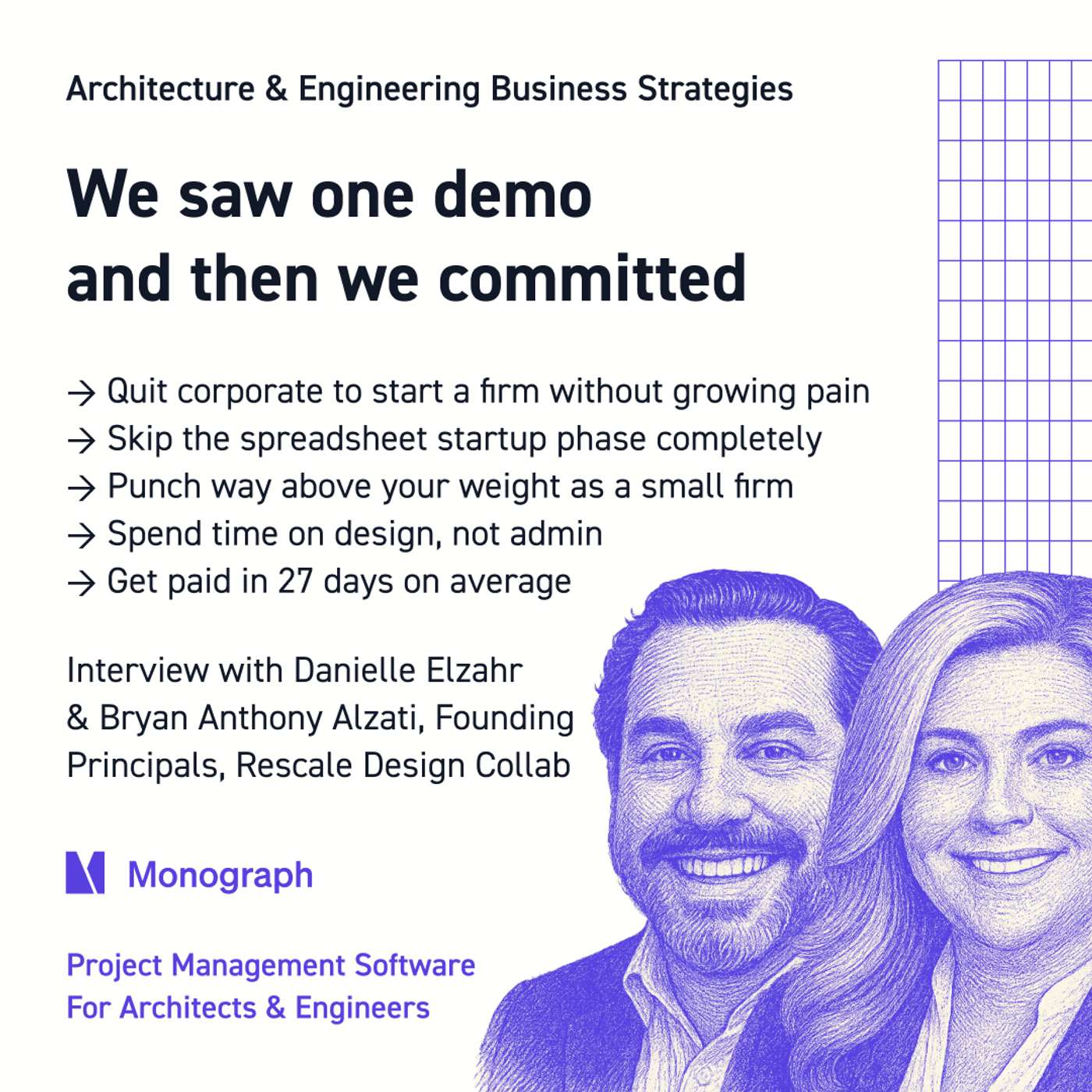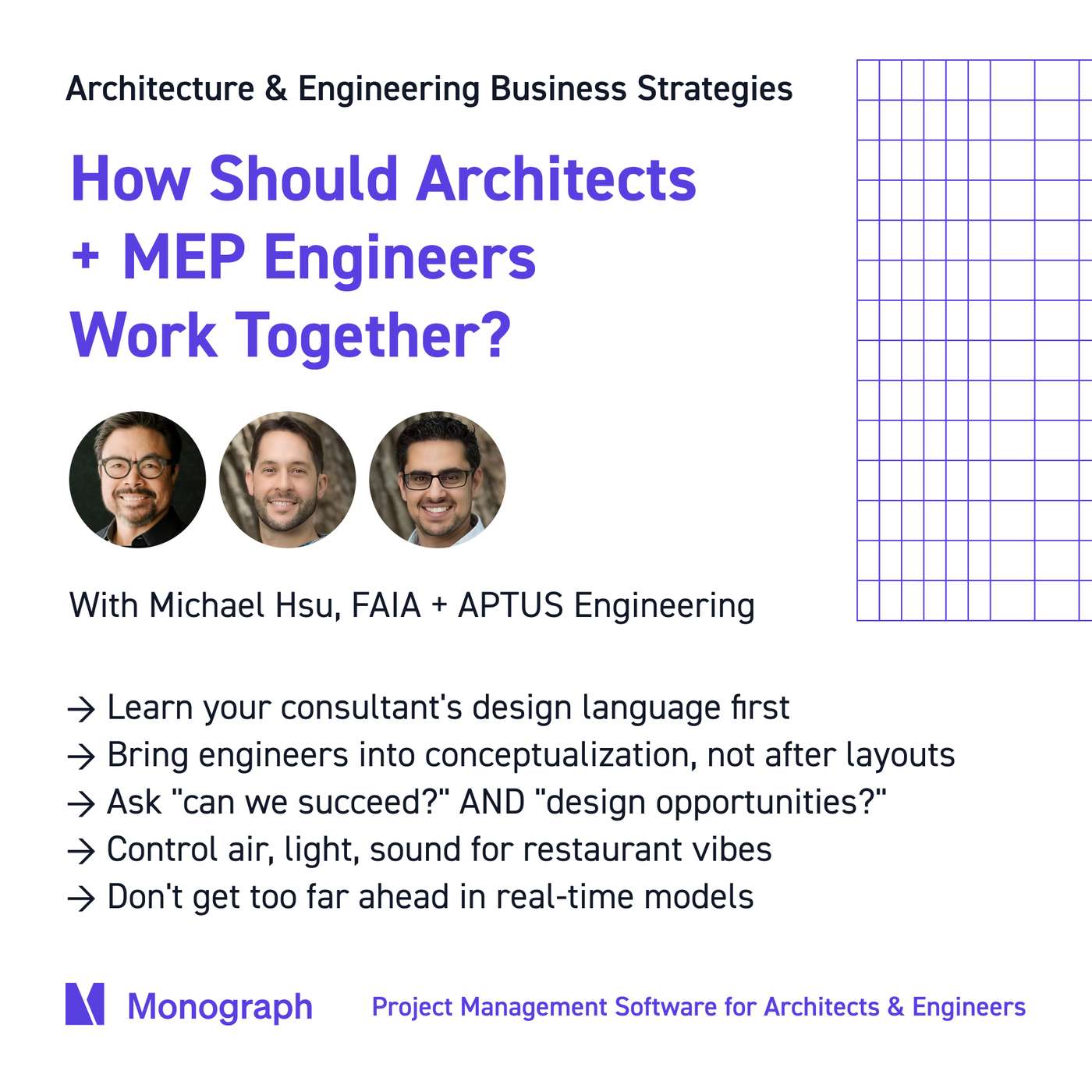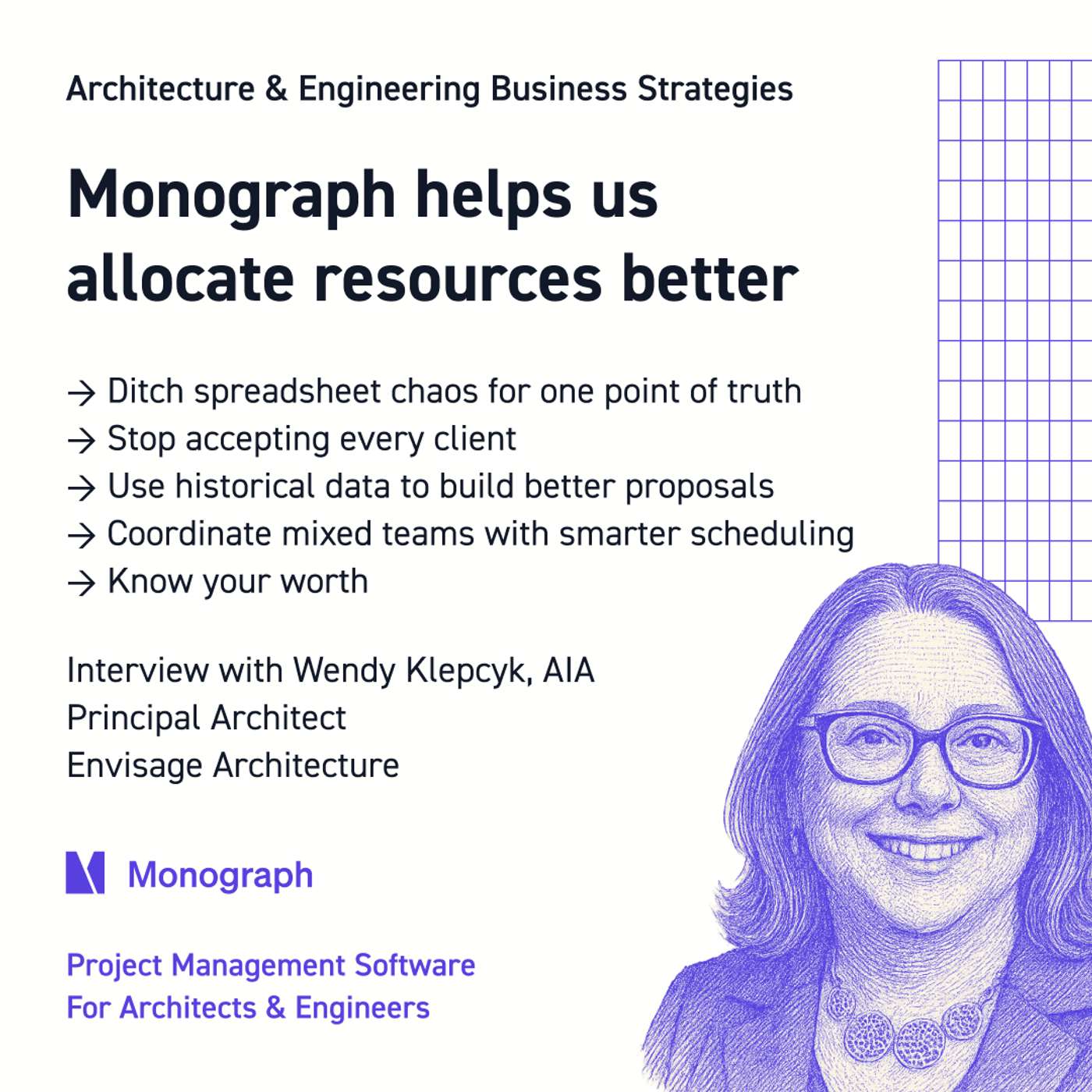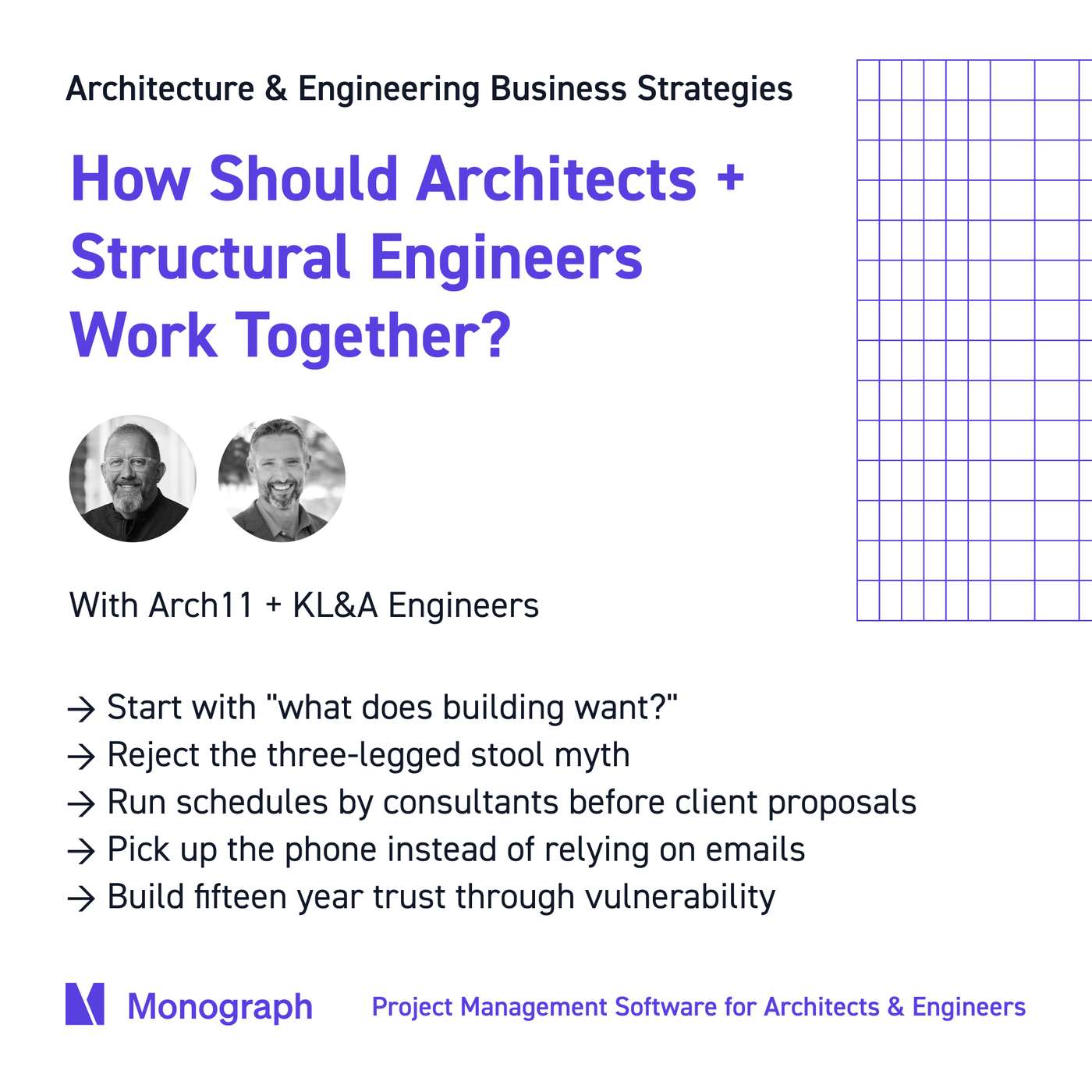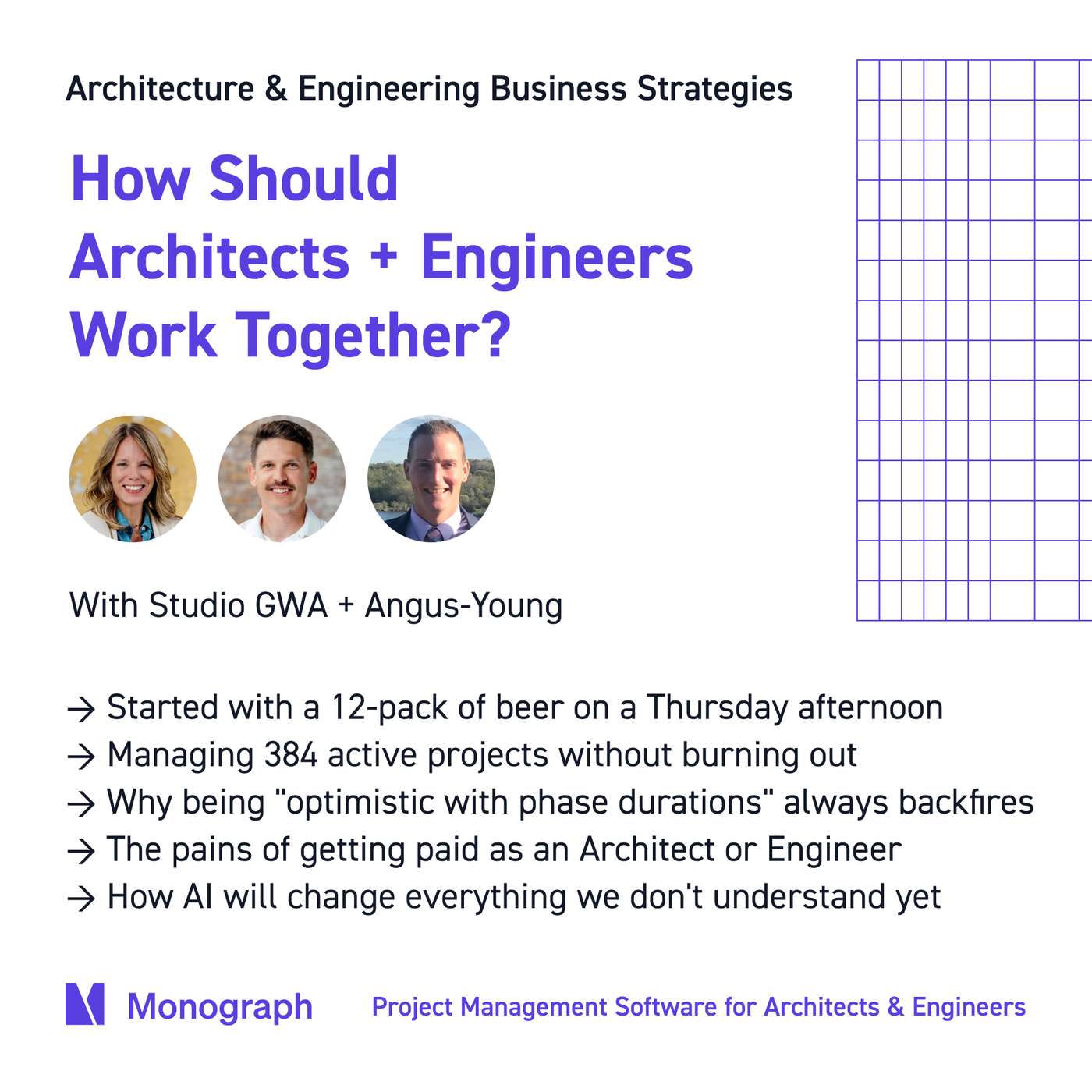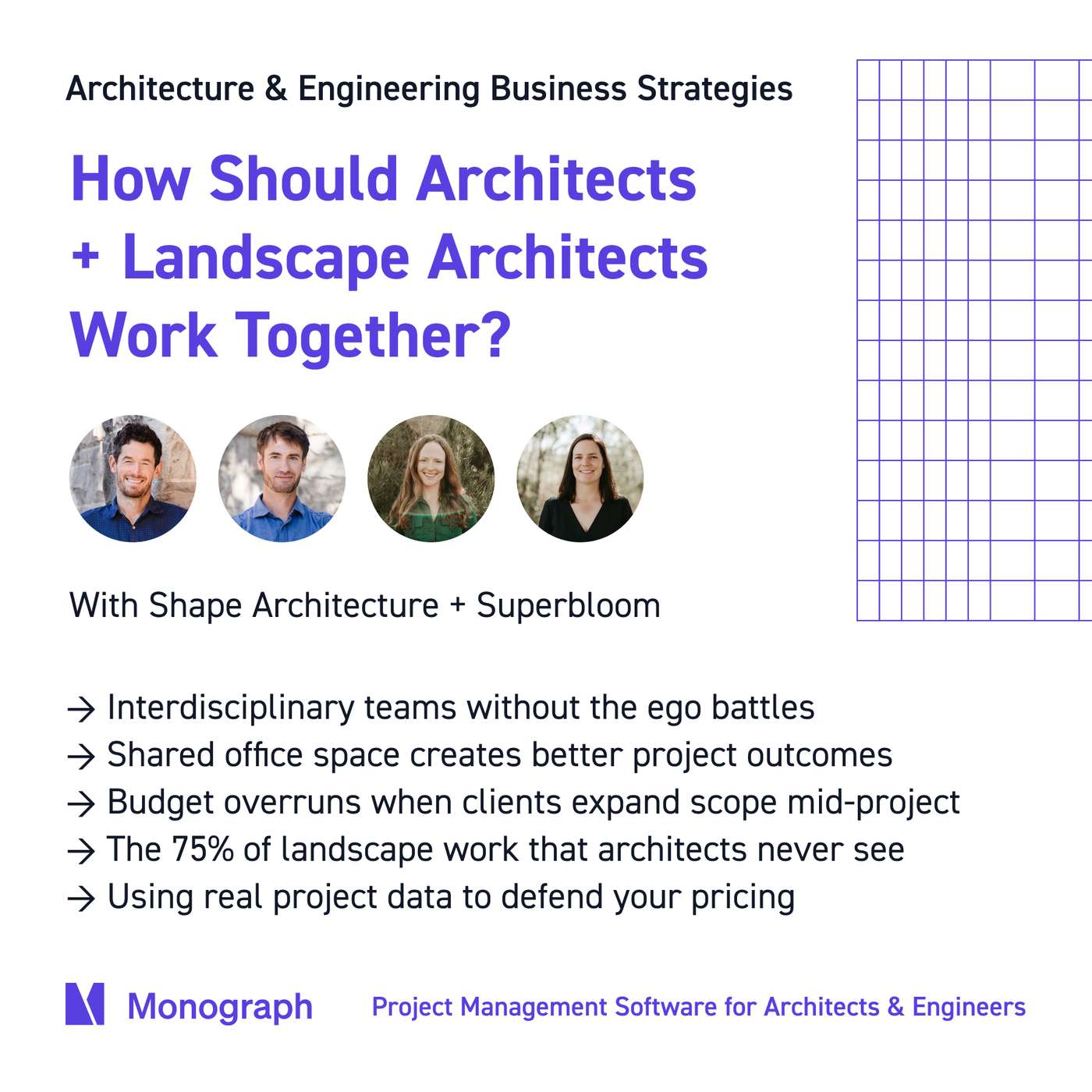Discover Architecture & Engineering Business Strategies
Architecture & Engineering Business Strategies

Architecture & Engineering Business Strategies
Author: Monograph
Subscribed: 20Played: 109Subscribe
Share
2019–2025 © MONOGRAPH INC
Description
Welcome to The A&E Business Strategies—a podcast hosted by Monograph about the architecture and engineering leaders who run great projects and firms. Monograph is the easiest project management software used by 12,000+ architects & engineers to manage projects on time, on budget, and profitably. Learn more about how it works at Monograph.com
92 Episodes
Reverse
Why don't Architects sketch with clients anymore? And why don't Engineers invest in teaching their Architect collaborators? These two Austin firms have revolutionized collaboration by front-loading coordination, using paper to build trust, and aligning billing phases perfectly.In this episode, you will learn:→ Why front-loading structural knowledge eliminates late-stage coordination disasters→ How paper sketching prevents "too precious" client paralysis in early phases→ The transparent billing model that forces perfect architect-engineer phase alignment→ Why trust reduces process steps and speeds project delivery→ How to break the linear design-coordinate-redline cycle that burns monthsMeet our guests:Maggie Wylie, AIA, is founder of Point B Design Group in Austin, Texas, specializing in residential and commercial projects with a focus on collaborative efficiency. Moises Cruz is principal structural engineer at A-1 Engineering, bringing military training and forensic expertise to prevent construction failures. Together, they've completed 6 projects with 4 more in progress.Ready to monitor your business health and make smarter decisions about when to hire, find work, or pull back? Join over 12,000+ Architects and Engineers on Monograph! Get started at https://monograph.com
In this episode, two ex-corporate architects explain how running their own business actually meant less admin than being employees at a large company.What you'll learn: → Why small firms can now punch above their weight with the right tools → How to set up professional operations in 30 days instead of months → The payment processing strategy that gets you paid in 27 days → Why custom corporate tools often create more problems than they solve → How to focus on design work instead of managing business systemsDanielle Elzahr and Bryan Anthony Alzati are the founding principals of Rescale Design Collab, a boutique architecture and interiors firm in Miami. They left successful careers at a large corporate firm to build a practice that prioritizes design over administrative overhead. With three people and a network of production partners, they work with commercial clients while maintaining the personal attention only small firms can provide.Ready to build professional operations from day one? Learn more at monograph.com
Creating the perfect restaurant vibe requires controlling air temperature, velocity, day lighting, and acoustic quality all at once, but most architect-engineer teams can't coordinate at this level.In this conversation, you'll hear how these Austin-based firms have sustained their decade-plus partnership working on everything from P. Terry's locations to the iconic Headliners Club renovation. They share their approach to early MEP integration, project selection criteria that protect both profitability and design ambition, and the trust investment required to learn each other's design language.What you'll learn:→ Framework for selecting projects that balance financial viability with design ambition→ Why bringing MEP engineers into conceptualization prevents expensive redesigns→ How to achieve precise technical coordination for hospitality experiences→ Trust investment strategies for building decade-plus consultant partnerships→ Real-time collaboration challenges and timing protocols that actually workAbout the guests:Michael Hsu, FAIA leads Michael Hsu Office of Architecture, a nationally award-winning practice in Austin focused on hospitality-driven projects. His design philosophy roots in empathy, storytelling, and aesthetic connection to culture and nature. Eric Zissman and Sujay Regmi co-founded APTUS Engineering, a performance-driven MEP firm known for service-oriented culture and collaborative approach across commercial, healthcare, and educational sectors.Ready to improve your project coordination? Monograph helps architecture and engineering firms track projects, manage resources, and collaborate more effectively. Learn more at https://monograph.com/
Architecture firms often accept any project that comes their way, but what if you could use data to choose only the clients who value your expertise?In this episode, you will learn:→ How to replace fragmented spreadsheets with unified financial tracking systems→ Why historical project data transforms proposal accuracy and profitability→ How to identify profitable vs. unprofitable project types using past performance→ Unexpected scheduling benefits for firms with mixed employment models→ How financial clarity gives you confidence to price appropriately and choose better clientsMeet Wendy Klepcyk, AIA, Principal Architect at Envisage Architecture, a 8-person Cincinnati firm that evolved from reactive project acceptance to strategic client selection through three years of data-driven decision making.Ready to gain financial clarity like this Architect? Learn more at https://monograph.com
Most architects treat engineers like a service you hand work to, but what if your breakthrough moments happen when you start conceptual conversations before making any structural decisions?What you'll learn:→ Why bringing consultants to the table "as quickly and early as possible" unlocks structural innovation most firms never discover→ How to reject the three-legged stool myth and achieve budget, schedule, AND quality through honest upfront planning→ The resource coordination system that prevents "everyone else's fires from becoming your fire" across multiple firms→ Why picking up the phone beats endless teams chats for solving complex design problems fast→ How fifteen-year professional partnerships enable vulnerability and breakthrough collaborationIn this episode: Ken and Jeff reveal how their fifteen-year partnership transforms projects through early integration, transparent resource planning, and maintaining human connection in an increasingly digital world. From conceptual conversations about "what the building wants to do" to weekly coordination meetings that prevent project chaos, this episode challenges every assumption about how architects and engineers should work together.Guest Bios:Ken Andrews is a principal and partner at Arch11 in Boulder and Denver, delivering artful and resilient design across residential, commercial, and institutional scales for over 20 years.Jeff Myers is an executive principal at KL&A Engineers and Builders, a 30-year-old firm generating $40-50 million annually across five Rocky Mountain offices. With 25 years of structural engineering experience and an architecture degree, he brings unique dual-discipline perspective to collaborative practice.Ready to transform your consultant relationships? Visit https://monograph.com to see how over 12,000 architects and engineers coordinate resources and manage projects.
Architects don’t design alone. But real collaboration between firms? That’s the hard part.In this episode, you’ll learn what it actually takes to run successful projects across architecture and engineering teams, such as:→ How to build trust between teams and clients→ How to structure timelines across consultants→ How to handle late invoices, design surprises, and municipal curveballs→ The role of tools like Revit, Monograph, and Deltek→ How to manage 384 active projects without burning out→ What’s changing next in A&E collaborationBe sure to listen until the end to hear the mistakes that taught them how to work smarter together.About our guests:💜 Studio GWA: A 14-person firm focused on adaptive reuse and urban planning, led by Jennifer Spencer and Aaron Holverson.💜 Angus-Young: A 60+ person full-service architecture and engineering firm, led by a team of principals, including Steven Genin.💜 Hosted by Monograph. Project management software built for architecture and engineering teams. Curious about Monograph? Get started -> https://monograph.com/book-a-demo
A&E project collaboration sounds great–until projects go over budget, scope gets muddy, and no one's sure who's doing what.In this episode, two award-winning design firms share how they actually make collaboration work: → How to staff and structure projects across two firms → How to run weekly planning and manage deadlines → How to divide scope, run client meetings, and stay on track → What tools to rely on: Slack, trace paper, Monograph, and more → How should Architects + Landscape Architects work together?Make sure to listen until the end to hear what they'd never do again!In this conversation, you'll hear about:How Shape and Super Bloom started working togetherWhat kind of projects each firm focuses onHow many projects they're working on at onceHow they structure projects across teamsHow they structure their time week to weekHow they handle client interactions and site meetingsWhat tools they use for team collaboration and designHow architects and landscape architects should work togetherWhat project really tested their collaboration—and how they handled itThe most unexpected thing that helped them collaborate betterWhat architects misunderstand about landscape architects—and vice versaWhat ways of working they'd never go back toQ&A: Is collaboration worth the budget risk for better outcomes?Q&A: When did they adopt Monograph, and why?🟡 Shape Architecture is a Colorado-based firm recently recognized as the 2024 AIA Colorado Young Firm of the Year. Led by Principals Steve Scribner and Morgan Law, they focus on creating high-performance, site-connected buildings across the Mountain West.🟢 Superbloom is a landscape architecture studio recently awarded a 2024 ASLA Colorado Merit Award for their innovative, climate-adaptive designs. Led by Principals Stacy Passmore and Diane Lipovsky, the team focuses on connecting people to landscapes in ways that are meaningful and resilient.💜 HOSTED BY MONOGRAPH The easiest project management software for Architects & Engineers. Get started now: https://monograph.com/book-a-demo
Unbilled hours. Constant firefighting. Are broken systems holding back your A&E firm? In this episode, you’ll learn a simple question to find broken systems and get a concrete example of how a 10-person structural engineering firm in Florida grew profits by 25% after switching from Excel to Monograph. Key takeaways:Ask your team to perform the same task—if their results differ, your systems lack consistency and need fixing.Use tools that visually show budgets, workloads, and schedules to make faster, more confident decisions.Implement systems that automatically track billable hours and improve communication to recover lost revenue.Need to streamline your firm? Visit monograph.com to get started.
Many architects and engineers struggle to manage their business, from staying on top of budgets to streamlining invoicing and forecasting. In this episode, we explore how Workbench, a California architect-developer + design-build firm, transformed their operations. By switching to Monograph from BQE Core + Smartsheets, they reduced unbilled fees by 75%, cut their billing time from 20 hours a month to just 4 hours, and sped up staffing and scheduling for their team by 8x.In this episode, you'll learn:How to give your team real-time clarity on project budgets and schedules.How Monograph simplifies invoicing, forecasting, and staffing adjustments.How better tools can help reduce inefficiencies and improve team productivity.Workbench used Monograph to save time, improve transparency, and focus on growing their business. If you’re ready to spend less time managing spreadsheets and more time doing the work you love, this episode is for you.Want to learn more? Visit monograph.com to book a demo today!
Many architects and engineers feel overwhelmed by the business side of their work. In this episode, we explore how Workshop/APD, a leading multidisciplinary design firm, tackled these challenges and grew their team by 78% with Monograph.In this episode, you’ll learn:How to align your team with real-time project and financial data.How to take control of your firm’s financial health using tools designed for architects.How to build a culture of accountability that empowers your entire team.If you’re ready to solve the business challenges in your firm and scale with confidence, this episode is for you. Listen now and discover actionable strategies to grow your firm while staying focused on what you love—design.Want to learn more? Visit monograph.com to book a demo today!
Meet Garrison Architects — a Brooklyn-based architecture firm that specializes in sustainable, modular building design through highly refined modernist aesthetics across private residential and large scale public projects. In 2023, the firm left ArchiOffice for Monograph to streamline and improve project tracking, staffing, and billing, while reducing the cost associated with managing their systems by 50%.Here's what happened: Before Monograph- +$34k annual cost on project management and billing systems- 40-48 hours a month on monthly invoicing- 45-60 days time-to-paymentAfter Monograph- 50% reduced cost on project management and billing systems- 66% less time on monthly invoicing- 2.6x faster time-to-paymentRead the story here - https://bit.ly/49nlNJpNew to Monograph? Start here - https://bit.ly/4bI3S1N
Meet the design-build firm Woodhull — an integrated architecture, construction, and millwork firm delivering thoughtful and enduring residential and commercial projects throughout New England. Their holistic ethos and business model relies on transparency, communication, and collaboration to drive successful internal operations. Everything starts with the 80 active projects in Woodhull's 25-person design studio, which switched from BQE Core to Monograph to improve speed and accuracy across the entire business.Here's what happened: Before Monograph- 4-6 hours per week on reporting latest project schedules- 5-10 days invoicing process due to back-and-forth between PMs and bookkeeper - 50% errors on retainer fee invoicing, causing client refundsAfter Monograph- 95% less time preparing project reports for firm owners- 53% faster monthly invoicing process- 100% error reduction on retainer invoicing, avoiding client refundsRead the story here - https://bit.ly/3OBJ7LjNew to Monograph? Start here - https://bit.ly/3w8y4mx
Systems are essential to organizing your workplace and maintaining order during a project. But how can you build systems to win new work? In this Best Practice interview, MVRDV Managing Director Inger Kammeraat and Strategy and Development partner Jan Knikker explained how they structure their firm to facilitate a healthy pipeline of new projects. They talked about how they use PR to drive business development, how they balance profit with their mission and how they close the cycle at the end of each project.Interview TakeawaysDocument new systemsBuild a supportive cultureDon’t kill creativityUse PR to showcase your winsClose the project cycleCheck in regularlyAlign with the client’s goalsBalance profit with missionOverbook your projectsSet boundariesShow LinksConnect with Jan Knikker on LinkedIn or TwitterConnect with Inger Kammeraat on LinkedInCheck out MVRDVConnect with George Valdes on LinkedIn or TwitterConnect with Chris Morgan on LinkedIn Check out MonographFollow Monograph on LinkedIn or InstagramListen and read more about Monograph
Forming the identity of a young business is difficult. Whether you’re branching off from a parent company or launching your own startup, without a consistent set of principles and practices, it can feel like you’re living in the Wild West. If you want your business to flourish, you need to establish law and order—namely, a consistent set of workflows and processes that will keep everyone on the same page. In this Section Cut interview, Adam Gayle, Director of Architecture at Level Architecture + Interiors, shared how you can help your business level up by organizing your practices and processes.Interview TakeawaysEstablish your identityCreate consistencyStart with good documentationGuide your employeesGet the right peopleBe transparentIdentify your weaknessesBreak down projects by phasesForm intentional habits Generate staff buy-inShow LinksConnect with Adam Gayle on LinkedInCheck out Level Architecture + InteriorsConnect with Nathan Malone on LinkedInCheck out MonographFollow Monograph on LinkedIn or InstagramListen and read more about Monograph
One challenge architects face is the pressure to deliver their signature creative style while also serving the client’s needs. This push-and-pull relationship between creative practice and professional service never goes away, but there are a few tactics you can use to help strike a balance. In this Section Cut interview, Principal Steve Perce of bldg.collective explored how to deliver an excellent client experience while also honoring your creativity. He talked about the importance of guiding the conversation, educating them throughout the process, and creating moments of delightful design.Interview TakeawaysGet in the right mindsetGuide the conversationConnect over creative opportunitiesCreate moments of delightful designCommunicate the impact of client decisionsAlign on goals and schedulingEducate clients through the processTailor your conversations to the clientTreat your work as an ongoing practiceBalance creativity with feasibilityShow LinksConnect with Steve Perce on LinkedIn or TwitterCheck out bldg.collectiveConnect with Nathan Malone on LinkedInCheck out MonographFollow Monograph on LinkedIn or InstagramListen and read more about Monograph
Industry expectations and standards are constantly shifting. If you want your company to keep up, you have to adjust with the changing times. But to be ready for whatever lies ahead, you have to institute a flexible, agile mindset within your company and be ready to adapt to new practices. In this Section Cut interview, Lorena Galvao, co-founder of Defining Design Practice, shared her experience working in the changing architectural industry and how companies can prepare for future shifts.Interview TakeawaysSpend your time wiselyPrepare tomorrow’s leadersFind communityRecapture your market shareThink forwardFocus on innovationGive opportunities to younger peopleKeep adaptingDiscover your nicheFind your communication channel Show LinksConnect with Silvia Lee on LinkedInConnect with Lorena Galvão on InstagramCheck out MonographFollow Monograph on LinkedIn or InstagramListen and read more about Monograph
The client experience is at the heart of architectural work. Delivering an attentive experience through every phase is what will lead to a happy client, repeat business, and referrals for your firm. In fact, this experience starts before you even land a client. Becoming in tune with your potential clients’ feelings, thoughts, and questions will help you to meet them where they are. In this Section Cut session, Lucas Gray and Dena Alspach of Charrette Venture Group explained how delivering an excellent client experience from day one is what will elevate the relationship with your client beyond a transaction.Interview Takeaways:Get in tune with potential clients’ feelingsNurture the client relationshipSet the right expectationsStrengthen your onboarding processFind the best way to share documentsDocument when you reach milestonesReach out to the client regularlyShow where the money is goingGet feedbackCheck in annually after a project closesShow LinksConnect with Lucas Gray on LinkedIn or TwitterConnect with Dena Alspach on LinkedIn or TwitterCheck out Charrett Venture GroupConnect with Joann Lui on LinkedInCheck out MonographFollow Monograph on LinkedIn or InstagramListen and read more about Monograph
When growth is rooted in community, it becomes self-sustaining. At landscape architecture firm Studio Balcones, Principal Jennifer Orr and Office Manager Tiffany Rasco believe that being active in their community is essential to their firm’s growth and success. In this Best Practice interview, they talk about the importance of educating others by collaborating with project partners, applying for community certifications, participating in diversity programs, and teaching clients throughout the process to ultimately create designs rooted in the local landscape.Interview TakeawaysCreate designs rooted in existing ecologiesDesign for the soil in each neighborhoodAlign with the project partnersGet involved in community programsBe prepared to wear multiple hatsWork with the landscape, not against itEducate clientsHire the right amount of handsBuild systems as you growHave the confidence to try something newShow LinksConnect with Jennifer Orr on LinkedInConnect with Tiffany Rasco on LinkedInCheck out Studio BalconesConnect with Silvia Lee on LinkedInConnect with Nathan Malone on LinkedIn Check out MonographFollow Monograph on LinkedIn or InstagramListen and read more about Monograph
Studio-based organizations can prevent architects from getting their hands on a variety of projects and experiences. Ennead Architects takes on a whole range of different scales, different typologies, and different locales in their projects. They see that as the dream training of an architect. Their teams are able to share ideas and transfer skills through this spectrum of projects. In this episode, Ennead partners Molly McGowan and Thomas Wong discuss how they manage all of their diverse civic projects, build teams, and define success.Interview TakeawaysBuild better architects with diverse projectsMerge business and creative goalsHelp clients make the right decisionsBuild trust and relationshipsBe proactive about filling in where neededStaff team strategicallyRely on peers for validation and inspirationCreate a lasting impactCultivate a culture of client serviceHave a tech leader on each teamShow LinksConnect with Molly McGowan on LinkedInConnect with Thomas Wong on LinkedIn Check out Ennead ArchitectsConnect with George Valdes on LinkedIn or TwitterConnect with Silvia Lee on LinkedIn Check out MonographFollow Monograph on LinkedIn or InstagramListen and read more about Monograph
In the architect-led design-build model, the architect is responsible not only for design but for construction as well. This represents a major shift from the traditional design-bid-build way of building projects. Yet it offers unique advantages on both the architect and client end, say Thomas Gluck and Stacie Wong, both principals at Gluck+. Most importantly, it makes for a smoother construction process and a better, beautiful building.Interview TakeawaysDesign for the buildBe the one point of contactScale by hiringPreserve what mattersAsk contractors for advicePrice early and oftenZoom in and outDiversity to problem-solveFeed your architecture addictionShow LinksConnect with Thomas Gluck on LinkedIn Connect with Stacie Wong on LinkedInCheck out Gluck+Connect with George Valdes on LinkedIn or TwitterConnect with Chris Morgan on LinkedIn Check out MonographFollow Monograph on LinkedIn or InstagramListen and read more about Monograph


